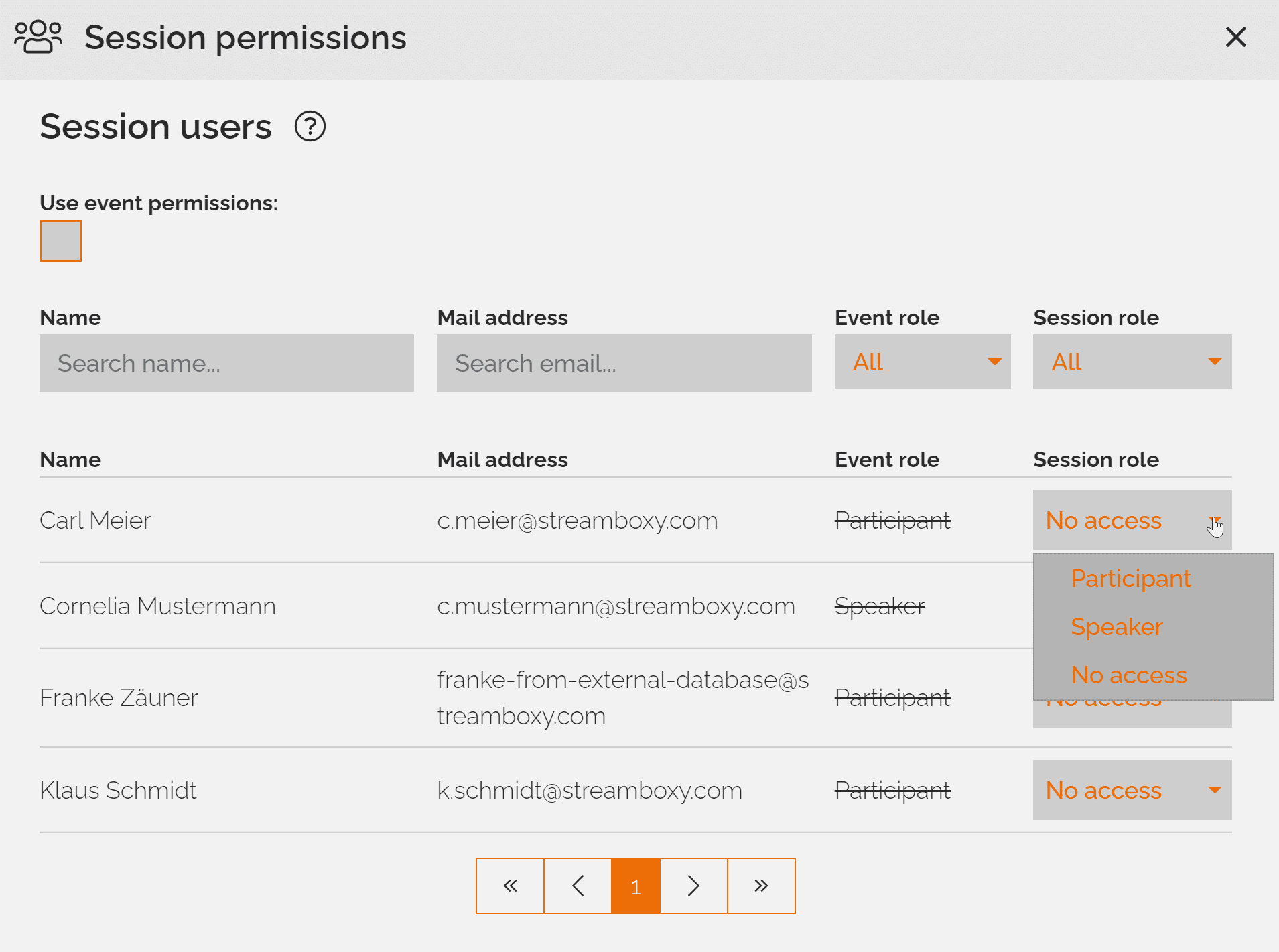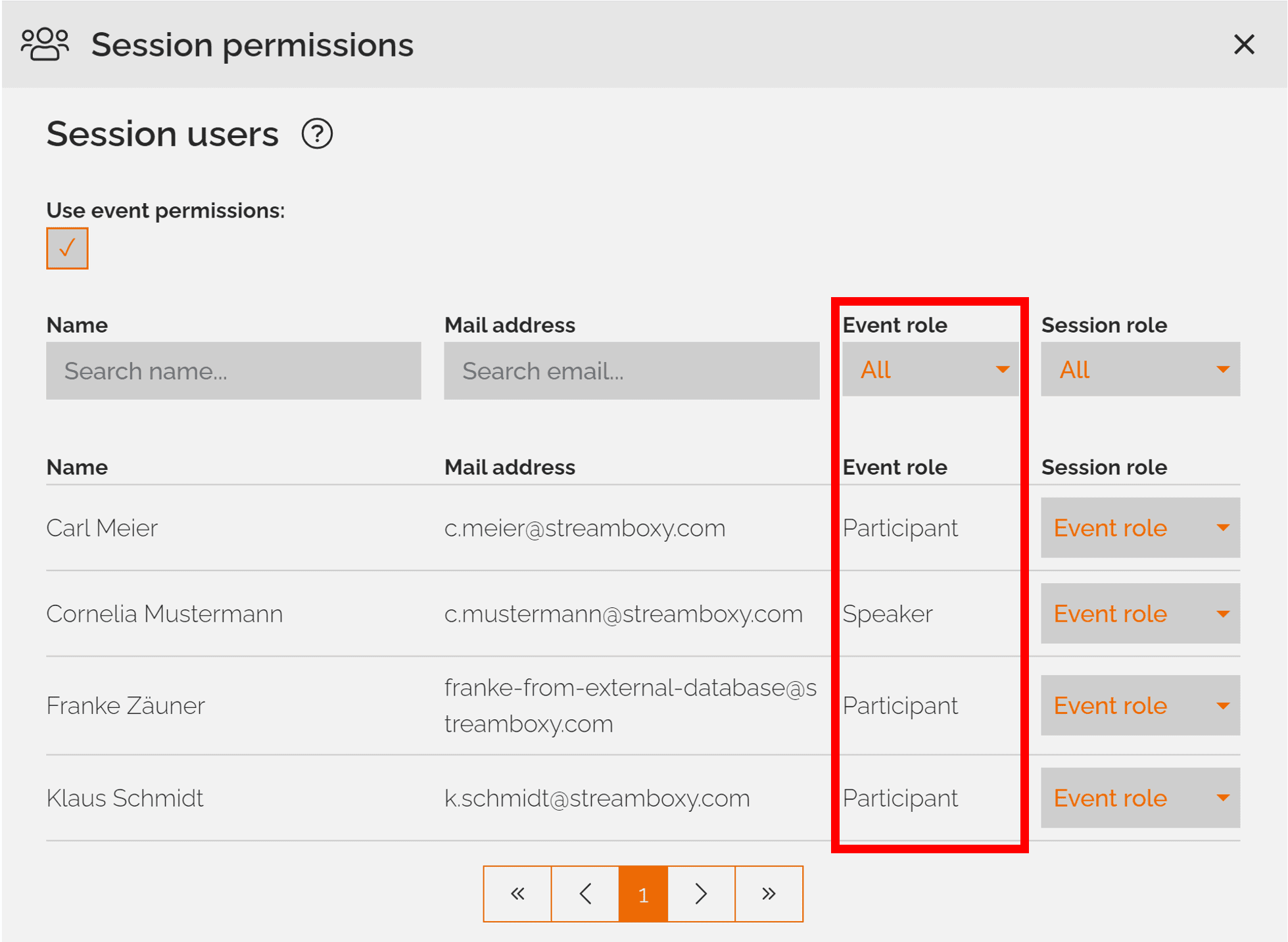
 What does this article say?
What does this article say?
This article explains how to distribute certain permissions (roles) for individual sessions (breakout sessions) and what this function means. It also describes how to set whether the names of the participants are visible to each other or not.
Find more information on creating and configuring the agenda and (sub-)sessions here.
What are session permissions?
Participants can be assigned different roles for individual sessions, which are different from the original event role. For example, an event participant is an attendee during the entire event, but moderates in one session and is thus assigned the speaker role exclusively for this session.
Another use case is that a participant has access to different sessions during the event depending on their authorisation - if they do not have authorisation, this session is not displayed to them.
By default, the event roles are automatically transferred to the individual session in the settings and then each participant is individually assigned a different role.
This function makes it easier for you as an organiser to manage separate permissions in sessions without having to maintain participants individually.
Alternatively, you can set that sessions do not inherit the event roles and that each event participant must be individually assigned the session authorisation and corresponding role.
Session permissions enable the following scenarios, for example:
- All users are authorised in the keynote, but have individually assigned sessions that are only visible to them.
- Users are participants in the event, but speakers in a session.
- session is not visible to certain participants
- One or more event participants can moderate in a session (as a speaker)
- Depending on the participant category, different VIP or press sessions are available
- Internal organisation sessions or test sessions
Where can I configure the session permissions?
The session permissions are configured in the STREAMBOXY Backstage in the event settings.
In the navigation bar in your event settings, click on the element "Agenda and Sessions".
Here you can create and adjust the agenda and configure sessions for the individual agenda items.
Detailed information on the "Agenda and Sessions" can be found here.
Session permissions can be created within an agenda item.
To access the permission settings, either create a new agenda item by clicking on "+ Add agenda item" in the upper right corner or edit an already created agenda item by clicking on the pencil icon to the right of the existing agenda item.
After the "New Agenda Item"/ "Edit Agenda Item" window has opened, scroll down to the "Permissions" item.
Under this item you can make the participant list visible to participants and configure the session permissions.
You can find detailed information on the remaining setting options for the agenda and sessions here.
Configure permissions
Under the item "Permissions", you can firstly make the participant list visible for participants in the stage and secondly configure the session permissions.
Both settings can be changed subsequently or live during your event.
1. Make participant list visible to participants
If you tick this box, the participants of the session are allowed to see the other participants. Otherwise, the list of participants is only visible to speakers.
Participants are therefore only visible to other participants if they use the chat.
2. Session permissions
Click on the button "Session permissions" to configure them.
A window opens that displays the session users. The name, email address, event role and session role of the respective person are displayed.
Use event permissions
The check mark in this field is set by default. This means that the event role of the persons for this session is taken over and you can define deviations for individual participants without assigning each individual participant a new role for the session.
In the "Event Role" column, you can see the corresponding roles of the persons for the entire event.
In the column "Session Role" you can see which role the respective person has for the corresponding session to be edited.
If (by default), as shown above, the permissions are taken from the event, "Event Role" is displayed for each session role. This means that a person who is a participant in the entire event is also a participant in this session - the same for the speaker.
Changing the session role for individual participants
To change the session role for individual participants, select either "Participant" or "Speaker" in the filter instead of the corresponding "Event role".
- Participant (the person is a participant in this session and can perform the participant functions).
- Speaker (the person is a speaker in this session and can carry out the (extended) speaker functions).
Do not inherit session permissions from the event
If you do not want to inherit the event roles for the corresponding session, uncheck "Use event permissions".
The roles of the persons in the "Event role" column are then crossed out; these roles no longer apply to the corresponding session.
By default, "No access" is selected as the session role, which means that these persons are not shown this session in their agenda and therefore cannot join it.
In the column "Session role" you can decide for each individual person whether they should either continue to have "no access" to this session or whether they should be assigned the role "participant" or "speaker".
- Participant (the person is a participant in this session and can perform the participant functions)
- Speaker (the person is a speaker in this session and can carry out the (extended) speaker functions)
- No access (the person is not authorised for this session and does not see it in the stage)
If a participant is authorised for a session, either as "participant" or "speaker", he or she can see it in the agenda in the stage, join the session and use it. If they are not authorised, the session disappears from the agenda.
Removing a participant from a (running) session
If you want to remove a participant from a (running session), you can also do this in the backstage. If the participant is in the corresponding session at the time of deletion, he/she will be moved back to the main session (lobby). The session will then no longer be visible in the agenda.
For more information on removing participants from (running) sessions, click here.
Filter
If you want to search for certain participants in order to authorise them or assign them a certain role, you can do this with the help of four filters.
Filter - Name
Enter here first and/or last name of the desired participant.
Filter - Mail address
Enter here the e-mail address of the desired participant.
Event role
Either display all persons or filter by "Participant" or "Speaker" to display only the appropriate selection.
For more information on STREAMBOXY roles, click here.
Session role
Either display all persons or filter by "Participant" or "Speaker" to display only the appropriate selection.
For more information on STREAMBOXY roles, click here.
Save edited session permissions
If you want to save your adjustments, click on "Submit" below.
